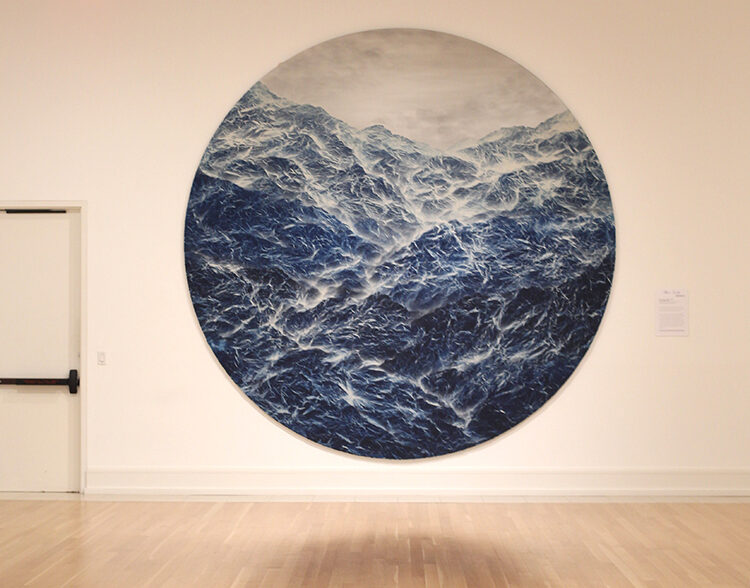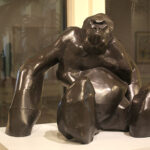
The artworks selected by Vero Beach Museum of Art staff for review and possible purchase by its Athena Society were a varied lot this year. They differed in media as well as stylistically, and were comprised of a mixed-media painting, a suite of etchings, a video work, a bronze sculpture and a photocollage.
These were created, respectively, by Americans Tara Donovan (b. 1945), Martin Puryear (b. 1941), Bill Viola (b. 1951), Daisy Youngblood (b. 1945) and Taiwanese artist Wu Chi-Tsung (b. 1981).
The winning pieces were determined by vote at a dinner for Athena Society members on April 22. As it happened, there was a tie between two artworks: Daisy Youngblood’s 1996 bronze sculpture “Gorilla,” and Wu’s Cyanotype photocollage with paint on paper, “121-2021.”
As your (generous) parent may have said when you were young: Well, if you can’t decide between the two, let’s get both of them.
The Athena Society represents one of the higher levels of VBMA membership, and was created for the purpose of giving museum members a hands-on opportunity to help build the museum’s collection holdings.
According to the 2020-2021 VBMA annual report, there are more than 100 current household members of the society. Each $5,000-per-year membership cost goes into the Athena purchasing budget and is in addition to a VMBA Chairman’s Club membership level or above.
This year the Athena Society had at least half a million dollars to spend. The two works by Youngblood and Wu totaled a smidge under $375,000, leaving the society some nice change to be paid forward toward next year’s purchase.
Many of the household members of the Athena Society are couples, and when it comes time for members to cast votes to select a purchase, each household is permitted two votes.
That feature has no doubt kept the peace in households where couples agree to disagree. A singleton household also gets two votes – a nice bonus for those who join solo. In addition to using their votes to bid on a work for purchase, society members can also cast a no confidence vote if they don’t like any of the works on display. If a majority of no confidence votes are cast, the society will not purchase a piece that year, and would roll those funds into the following year’s Athena budget.
Of all the works this year, Youngblood’s “Gorilla” was a stand-out. The massive-looking sculpture, 37 inches high and 45 inches at its widest, shows the great ape as though seated in a shallow pool; that is to say, the figure is truncated at the wrists and ankles.
The semi-abstract sculpture really doesn’t need hands and feet which, in any case, would have looked excessive next to the animal’s barrel-shaped arms and boulder-like legs, the latter drawn up before its hull of a belly.
The ape’s shoulders are twin representations of Thor’s hammer. They support a turned and slightly tilted anvil of a head, whose visage is as fierce as it is wise. It is the face of a king whose lineage is ancient and whose future extends no farther than the present.
Glossily finished in a warm black patina, “Gorilla” is the single artist’s proof from an edition of four. It comes from Van Doren Waxter in New York City, which featured “Gorilla” in its September-October 2021 solo show of Youngblood’s sculpture at the gallery. Titled “Tender Mercy(s): Early and Late Works in Clay,” the show was a survey of Youngblood’s career from 1977 to 2020.
The exhibition included both animal and human forms (mainly heads and skulls) created in the artist’s go-to material, low-fired clay, as well as “Gorilla.” With the exception of that bronze, and the 12-inch-high, smoky-fired white clay “Little Gorilla” (2020), the clay works were, by comparison, minimally obscure. That, according to the gallery’s website, is because Youngblood is noted for “an affecting, mystical body of sculpture made slowly through deep immersion with changing form.”
Youngblood is noted for her animal sculptures, and especially her primates. The latter are her most naturalistic works. For this writer, Youngblood’s primates are her most sympathetically rendered mammals, barring none; humans included.
Youngblood’s list of awards and honors is a long one that includes a John D. and Catherine T. MacArthur Fellowship (2003). Her work is in the permanent collections of the Modern Art Museum of Fort Worth, Texas; the Museum of Modern Art, New York; the North Carolina Museum of Art, Raleigh; and the San Francisco Museum of Modern Art.
The other purchase by the Athena Society, Wu Chi-Tsung’s “Cyano-Collage 121, 2021,” combines cyanotype photography with acrylic paint. It is from Sean Kelly New York.
Wu’s work in collage uses cyanotype photography and acrylic paint on Xuan paper, a type of smooth, soft-textured paper developed in China centuries ago. Its use by Chinese scholars of old for brush calligraphy and painting, materially connects Wu’s use of it to China’s great cultural traditions.
At a little over 12 feet in diameter, the tondo-shaped work is impressively large, with a deckle edge that appears to float against the wall on which it is mounted. The huge work was created in four sections, all of which are affixed to aluminum board for stability.
Decades ago, cyanotype was often used for reproducing large drafting plans. Yet the technique goes back to early non-silver photographic processes developed in Europe in the mid-19th century. The cyanotype process was initially developed as a simple method for copying handwritten notes. When photographers began using it soon thereafter, they used the process to record the world in cyanotype’s uncanny blue tones. The process has experienced revivals ever since.
Wu’s use of cyanotype’s indigo color for his depictions of water is especially apt. It’s a little scary to stand up close to “Cyano-Collage 121-2021” because, if your imagination is lively enough, you feel you are about to be inundated. The gray peep of sky above all that water shows that the weather is not fit for the ablest sailor, so what are you doing there?
The idea of making artworks about the sublime in nature goes back in Europe to J.M.W. Turner, whose large-sized, swirling storms of color surely made a Victorian or two swoon in ecstasy. In the U.S., Frederick Church gave paying audiences their money’s worth when he exhibited his iceberg paintings during and after the Civil War. In our own times, Latvian-born American Vija Celmins has reminded us in her many watery drawings and prints of the sea’s immensity, both as an enduring force in nature and an inexhaustible subject of art.
In other words, Wu is in good company.
Wu was born in Taipei, and currently lives and works there and in Berlin. The 40-year-old Wu is the recipient of numerous awards in Taiwan and Hong Kong which, until recently, had strong economic and cultural ties. His work has been included in international exhibitions in the People’s Republic of China, Japan and South Korea. In Europe his work has been seen in the United Kingdom and Luxembourg. In North America his artwork has been viewed in Los Angeles and Mexico City.
Wu’s work has been collected by Yu Hsiu Museum of Art in Nantou, Taiwan. In other parts of the world Wu is represented in museum collections in Seoul, South Korea; Istanbul, Turkey; Hong Kong; and Ho Chi Minh City, Vietnam. In the U.S., artworks by Wu are in the Santa Barbara Museum of Art and the Spencer Museum of Art (Lawrence, Kan.) collections.
Wu can now add one more museum collection to his resume: that of the Vero Beach Museum of Art.
Photos by Kaila Jones














